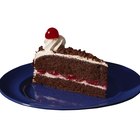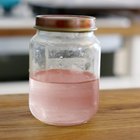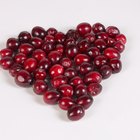
Cherries are stone fruits in the same family as plums, nectarines, peaches and apricots. They’re found in the summer months and don’t sweeten much after they’re picked. There are three types of cherries: sour, sweet and chokecherries. Sour are best in pies and preserves, while sweet cherries typically are eaten fresh. Chokecherries are exceptionally tart and typically used in preserves and syrups. Since cherries have a distinct flavor, a substitute must offer a similar tart, yet sweet, note to your recipe.
Substituting Loquats
Loquats might sound exotic, but you can find them in many grocery stores. This fruit has a succulent pulp that offers a sweet to tart flavor -- just like the cherry -- and they’re used in pies and preserves similar to cherries. When using loquats, buy peeled and seeded varieties or peel and seed them yourself at home; the peels and seeds aren't edible. Use loquats in equal proportions to cherries in your recipe. Loquats work well in all cherry recipes, including fresh recipes.
Use Frozen Cherries
If you can't find fresh cherries, dried, frozen or canned cherries work as adequate substitutes. Canned cherries may have additional sweeteners or preservatives, which might alter the taste of your recipe. Therefore, try finding frozen first, dried second and use canned as a final alternative. Frozen, dried and canned cherries can be used in equal parts for fresh cherries in all recipes. In most recipes you can use dried cherries as-is -- including baked goods -- but if you need to rehydrate them, do so by soaking them in water overnight in the refrigerator.
Try an Extract
Cherry extracts offer a sweet, slightly tart cherry flavor without the need for a real cherry. Use a pure cherry extract that's made from real cherries. Imitation extracts are not made from real cherries and contain artificial colors and flavors that turn bitter and can taste similar to cherry-flavored cough medicine. Extracts are more powerful than fresh cherries, so use a ¼ teaspoon for every 1 teaspoon of cherries in the recipe. Extracts are suitable for all recipe types except fresh salads or garnishes.
Add a Splash of Liqueur
Cherry liqueur can be used to give you a distinct cherry flavor without using fruits. Cherry liqueurs are sometimes available in grocery stores, but you can also find them in liquor stores. Cherry liqueur contains alcohol, so only use it if you're comfortable with the addition of alcohol in your recipe -- if your recipe calls for cooking on the stovetop, the alcohol might burn off, but baking in the oven might leave residual alcohol in the dish. Liqueurs pack a powerful flavor and can easily overwhelm a recipe. Use liqueurs in baked goods and cooked recipes, but not in fresh recipes. when substituting with liqueur, start with a ¼ teaspoon per 1 teaspoon and add more until you reach the desired flavor.
Open a Jar of Preserves
Preserves are a thick fruit spread. Unlike jams or jellies, preserves use thick chunks of the fruit and are cooked with sugar. Cherry preserves give you not only the cherry flavor, but pieces of real cherries. Use preserves in fresh or cooked recipes. Preserves offer a more concentrated flavor of cherry, but also have added sugar. When adding these to recipes you might notice a sweeter taste, so use a ratio of one part preserves for every two parts cherries that are called for in the recipe and add more as needed to reach the desired flavor.
Related Articles

Brandy Flavoring Substitute

Candied Fruit for Baking

What Is a Good Substitute for ...

How to Reconstitute Dried Cherries
Substitutes for Lemon or Orange Peel

What Is a Substitute for Cherry Liqueur?

Is There Anything That Can Be Used As a ...

Substitute for Framboise Liqueur

A Substitute for Elderflower Cordial

What Is Mixed Peel?

Galangal Powder Substitute

How to Freeze Raspberries

How to Make Flavoring for Rock Candy

Substitutes for Hazelnut Liqueur

How to Make Lemonade Using Meyer Lemons

How to Remove a Cardamom Seed From a Pod
Can You Make Fig Preserves Out of Dried ...

How to Add Fresh Cranberries to Any ...

How to Freeze Sour Cherries

Cooking Substitute for Tamarind ...
References
Writer Bio
Shailynn Krow began writing professionally in 2002. She has contributed articles on food, weddings, travel, human resources/management and parenting to numerous online and offline publications. Krow holds a Bachelor of Science in psychology from the University of California, Los Angeles and an Associate of Science in pastry arts from the International Culinary Institute of America.
Photo Credits
Photos.com/Photos.com/Getty Images